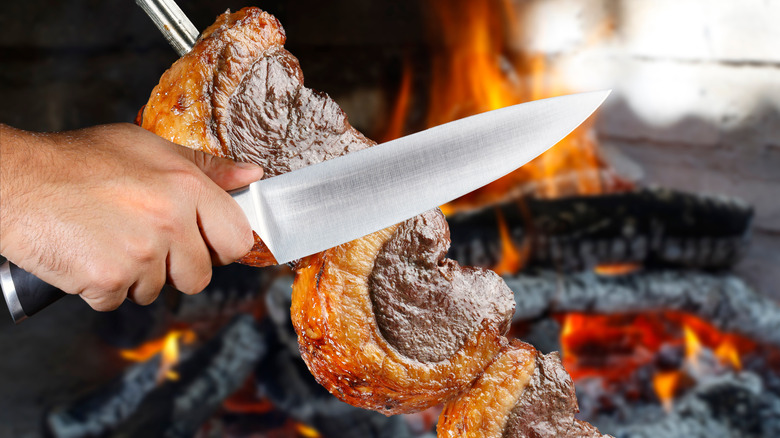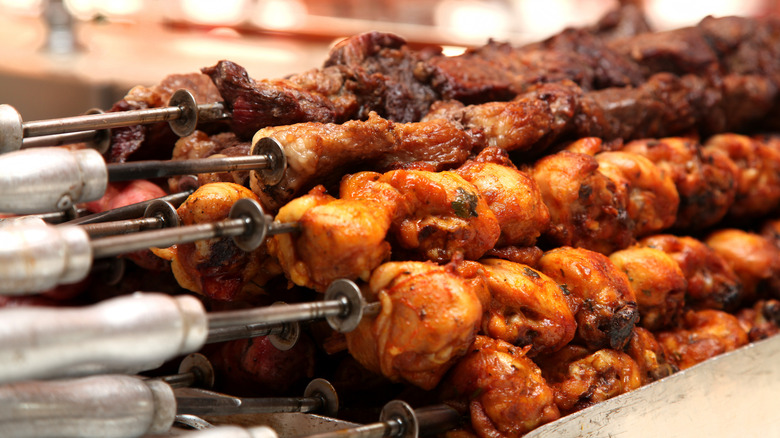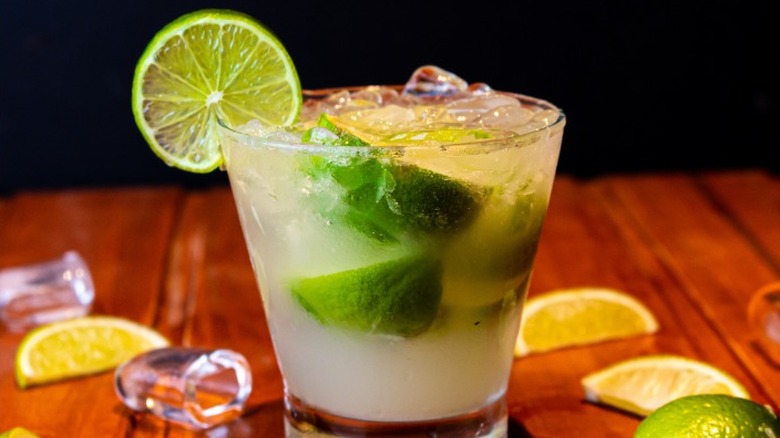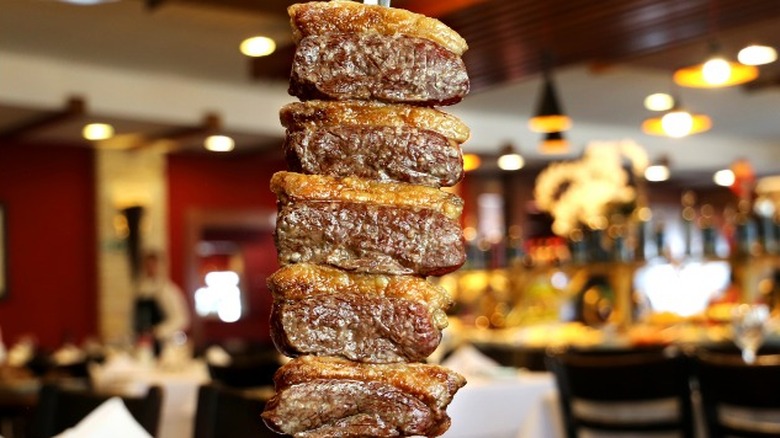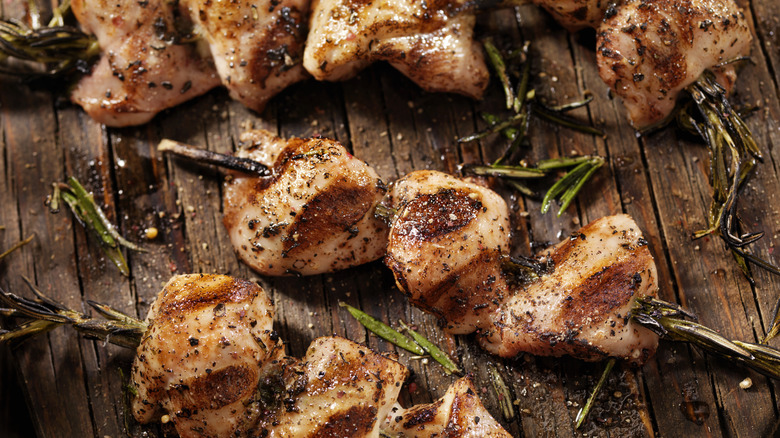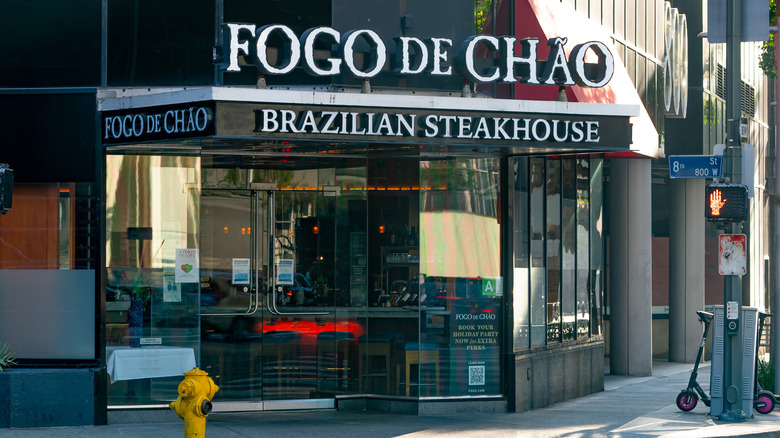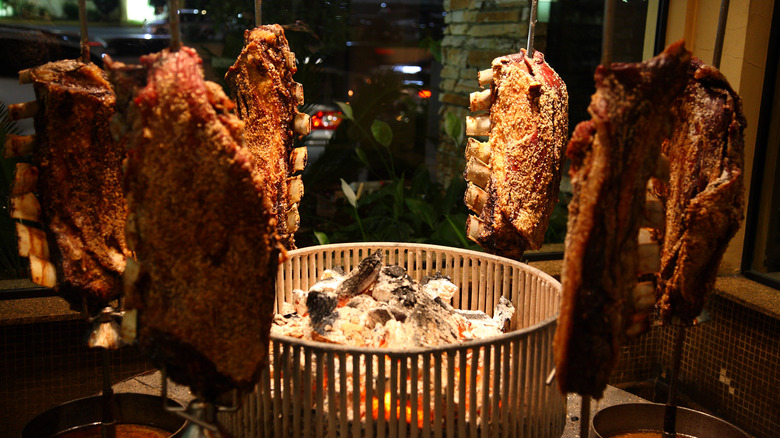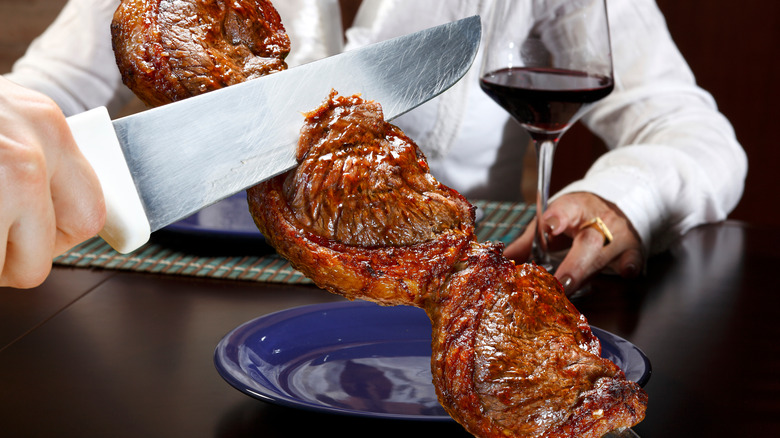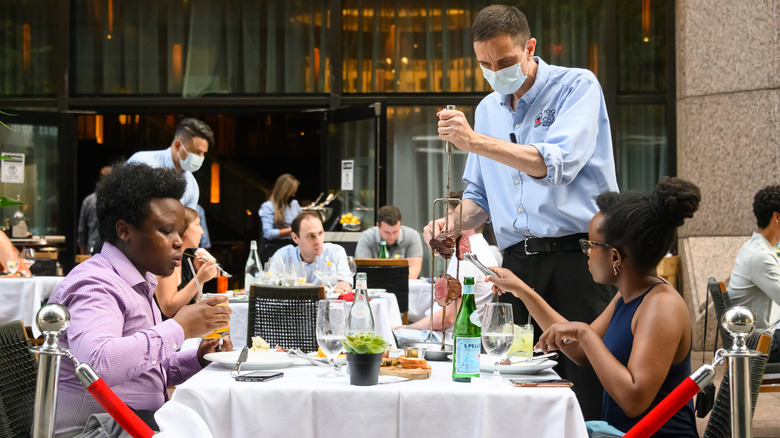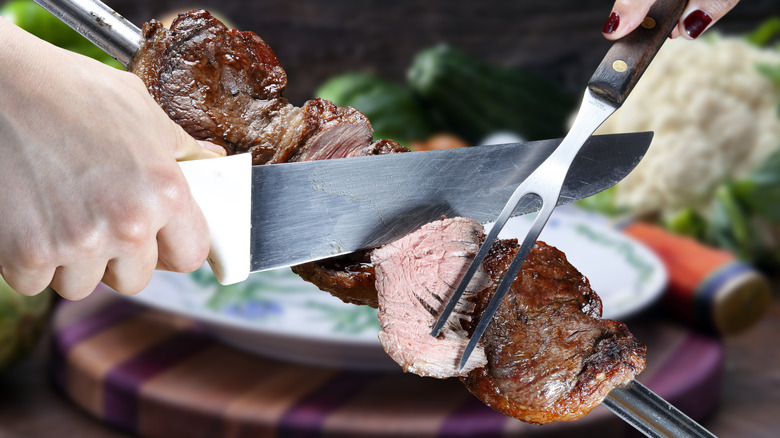11 Facts About Brazilian Steakhouses You Might Not Know
There are a few types of restaurants that are huge draws, not just for the tasty food, but for the total package and experience you have when eating there. Think of your favorite hibachi restaurant, buffet, or Korean barbecue. The food might be delicious, but that's only half the fun. The other half comes from the unique way that the food is prepared and served to you. Another restaurant that squarely fits into that category is the Brazilian steakhouse.
They're not like your garden-variety steakhouse. While many of the menu items may be similar, Brazilian steakhouses are distinct in that they operate on an all-you-care-to-eat business model. After paying one fixed price, diners are given green and red cards that signal to their servers whether they want more food brought to their table or not. It can be a lot of fun watching the rounds of servers rotating through the restaurant, shaving piece after piece of meat onto your plate. But there are probably a few facts about Brazilian steakhouses that you're not aware of, from their humble origins as far back as the 1800s to tips and tricks to have an easier time dining.
Get your appetite ready for some tasty Picanha and read up on these facts for the next time you visit a Brazilian steakhouse.
Brazilian steakhouses can trace their roots to the 1800s
For many Americans, Brazilian steakhouses may seem like a somewhat new phenomenon. But in fact, the beginning of the tradition dates back to the 19th century. During that era in what would eventually become the Western United States, cowboys herded the livestock being shipped out west for sale. At the same time, South American gaúchos served their communities in a similar way by handling all of the cattle. Not only did gaúchos manage the cattle, but they also prepared the meat for large gatherings, developing their own unique grilling techniques along the way.
According to Beleza Rodízio, the specific all-you-care-to-eat serving style known as "rodízio," or "rotation," was developed a little later in the 1930s. In this style, gaúchos would regularly come around offering slabs of freshly cooked meat presented on swords. The ritual was adopted into modern-day Brazilian steakhouses, where servers come around to each table throughout your meal offering more slices of various kinds of meat. This all-you-can-eat concept that makes Brazilian steakhouses popular today remains inspired by that original rodízio style of dining.
Yes, you will eat plenty of meat at Brazilian steakhouses
If someone invites you to a Brazilian steakhouse, be sure to bring a healthy appetite. In order to get the most value out of a meal at one of these unique restaurants, you need to be prepared to eat a lot of food. In particular, as the name implies, Brazilian steakhouses specialize in all different cuts of meat that will be brought out to your table in an all-you-care-to-eat rotation.
The exact kinds of meats served at a Brazilian steakhouse may vary, but you can usually expect to find traditional Brazilian cuts like the rump cap known as Picanha, a bottom sirloin cut called Fraldinha, and a top sirloin cut called Alcatra. Other cuts of meat like filet mignon may be included as well, though those are less traditional in Brazil than they are in the typical American diet. You may also spot other familiar varieties and cuts of meat like chicken, ribs, sausage, and lamb. Because Brazilian steakhouses operate on one fixed price, you can take as much or as little of each kind of meat as you would like when your servers rotate around to your table. You certainly will not leave feeling hungry.
There's usually a salad bar, but it may not be worth it
The thought of consuming an endless supply of meat might sound more appealing to some than to others. And while most meats are rich in protein, it might make you feel a bit weary to imagine eating so much in one sitting, especially considering how red meat can also come loaded with saturated fat. This is in addition to the fact that, since you're dining at a restaurant, you're likely to consume a bit more sodium than you would at home due to the amount used in the cooking process.
For those looking for ways to make sure their vegetables are included with dinner, Brazilian steakhouses traditionally come with a salad bar you can visit throughout your dining experience. You want to be careful, however, as salad bars at Brazilian restaurants may wind up being more of a hindrance to what you really came to enjoy. Don't let yourself fill up on salad items before the first slice of churrasco arrives at your table. Instead, grab a small side salad to balance out the steak, but keep room in your stomach for the meat. It is, after all, why those hefty Brazilian steakhouse prices are as high as they are.
Brazilian steakhouses strategically pick their sauces and beverages
Brazilian steakhouses are a meat eater's paradise, with an all-you-can-eat approach to dining and endless portions coming to your table. Life is all about balance, however, and even the most avid meat connoisseurs might grow tired of the taste after the first couple of rounds. Do not fear, as Brazilian steakhouses offer plenty of mouth-watering side dishes to accompany your steak. But these menu enhancements, even down to the drinks and sauces, aren't chosen at random. Quite the contrary, they're strategically picked by the restaurants to offer the best dining experience.
You will probably spot traditional Brazilian foods such as rice, beans, and fried plantains, but pay attention to other accompaniments with your meal. Many of the meats might come with a special vinaigrette sauce, and it's not just there for flavor. The acidity in the sauce balance with the fattiness of the steak. Another acidic menu item popular at Brazilian steakhouses is the signature drink, which many times is caipirinha, the national cocktail of Brazil. The lime-flavored beverage adds another note of acid that pairs perfectly with all of that grilled meat.
One cut of meat is more traditional at Brazilian steakhouses than others
Brazilian steakhouses, particularly the larger chains in the United States, want to cater to an array of tastebuds and cultural preferences when it comes to popular meats. As such, you can expect to find your favorite cuts like filet mignon brought around to your tables. But if you want to experience truly authentic Brazilian steakhouse dining, there's one cut of meat that you will want to keep your eyes peeled for and ask for extra of when your server brings it around.
This cut of meat is called Picanha, and it comes from the top part of a cow's rump. You may recognize it from your grocery store, as it's also sometimes referred to as the sirloin cap. Part of what makes the Picanha so distinct and popular is the top layer of fat that's left on as it cooks. The texture winds up coming out similar to that of a sirloin as well, making it a marvelously delectable cut of meat that's sure to be a crowd-pleaser at your table. You can't miss the Picanha when it makes its rotation around the restaurant, as it typically comes in a crescent shape with three or four cuts stacked on top of one another.
Some cuts of meat are almost always worth skipping
Some cuts of meat at Brazilian steakhouses are worth the visit alone, especially if the kitchen can cook up a delicious Picanha. But some portions of meat aren't always worth filling up on, whether that has to do with how much you paid to dine there, or simply because it's a more common cut of meat you can find at other places.
When eating at a Brazilian steakhouse, it's often advised that you steer away from chicken. It may be tasty, but you're dropping a considerable amount of cash to eat at the restaurant, so why fill up on what's probably the least expensive meat? You also want to eat as little ribeye as possible when at a Brazilian steakhouse -– not because it lacks flavor, but because you can likely find a decent ribeye at most other steakhouse chains. Instead, fill up on traditional South American meats like Picanha, chorizo, or Lombo. Just be sure to pace yourself and don't go too hard and fast the first time your servers come around. Pacing yourself can also help ensure that you give everything a try first and discover what your favorite cuts of meat are. Then, on the second round, you can load up on more of that.
Chain restaurants brought Brazilian steakhouses to a global audience
Brazilian steakhouses are time-honored traditions in Brazil, bringing large groups together for dinner for nearly 100 years. But the global phenomenon is a newer concept, popularized by the rise of chain restaurants. In particular, there are a few Brazilian steakhouse chains you may have heard of, like Fogo de Chão, Rodizio Grill, and Texas de Brazil. The rise of these chains is thanks to a push to bring Brazilian cuisine to a global audience, which has in large part taken place in the United States.
Fogo de Chão in particular has been able to capitalize on a growing interest in international cuisine across the U.S. in recent years. The chain originally started in Brazil in 1979 but came to the United States about 20 years later. It has all of the traditional markings of an authentic Brazilian steakhouse, including Brazil's national cocktail and its tasty Picanha. There are now dozens of Fogo de Chão locations across the United States, but if you don't have one near where you live, you're still likely not too far from another delicious Brazilian steakhouse.
The massive chains like Fogo de Chão will probably have a few more Americanized traits than the steakhouses you'd find in Brazil, particularly when it comes to additional cuts of meat like filet mignon and ribeye.
What many Americans know of Brazilian steakhouses today is known as Churrasco
When you bring up Brazilian steakhouses in conversation, a few images likely pop into mind: red and green paddles indicating your level of hunger to your waiter, juicy slabs of Picanha being sliced onto your plate, and a refreshing caipirinha to wash it all down. What most Americans know as the Brazilian steakhouse style is actually a very specific type of meat preparation and dining that was developed long ago. The Brazilian gaúchos of the 1800s developed a special approach to barbecuing that enabled them to serve large crowds with a simple slice of meat off the skewer.
Dining at a Brazilian steakhouse means that you're enjoying what is known as churrasco. It has a couple of different translations, but it essentially means a type of barbecue that takes place over a fire using skewers. In today's modern colloquialisms, churrasco can also refer to the actual slabs of grilled meat held on skewers that you find at a churrascaria. Whether you use it to reference the method of barbecuing or the meat itself, churrasco is what you will enjoy when dining at a Brazilian steakhouse.
There's a right and wrong way to start and stop service
Particular cuts of meat aside, there are a few other unique things about dining at a Brazilian steakhouse that you usually don't encounter at other restaurants. Even the traditional buffet doesn't operate in the way that these steakhouses do. When you're first seated at your table, each guest is given a card or paddle with one green side and one red side. When you flip your card over to the green sign, that indicates to the serving staff that you're ready for more food. When it's flipped so the red side is facing up, that indicates that you don't want any more food, so your servers will pass over your plate.
Many such establishments work quickly to get as much food out to you as soon as possible, so you may need to strategize how to signal for more meat at your Brazilian steakhouse and when to flip your card from red to green, or vice-versa. At some restaurants, more common meats are brought out first, so you may want to consider leaving your card flipped to red for the first few moments until you get a lay of the land. That way, you avoid filling up on less expensive meats like chicken. Don't be afraid to flip back to red if you need a break in between rounds.
Brazilian steakhouses weren't always so expensive
If you haven't dined at a Brazilian steakhouse before, you may be hit with a bout of sticker shock during your first visit. They're not necessarily value restaurants, even when you consider their all-you-care-to-eat business model. Meat is far from an inexpensive staple, and Brazilian steakhouses are known for serving quality food, which helps justify the hefty price. But they weren't always priced the way they are now.
In fact, the original Brazilian steakhouses catered to passersby as roadside stops. Due to the nature of local gaúchos handling the raw material, so to speak, cattle were plentiful and, therefore, cheap to sell at restaurants. Brazilian steakhouses also offered a filling meal to customers like truck drivers before they took off on their long journeys, according to Eater. Chain restaurants like Fogo de Chão seized on the opportunity to make Brazilian steakhouses a more fine dining affair, bringing what was once a roadside pit stop to metropolitan areas. Nowadays, dining at a Brazilian steakhouse is often reserved for special occasions.
You are better off dining at a Brazilian Steakhouse earlier in the day
The next time you consider dining at a Brazilian steakhouse, think about the time of day you want to visit. If you find one open for both lunch and dinner, you may want to opt for the earlier meal time. This is for a few different reasons.
For starters, Brazilian steakhouses have grown in price over the years. However, you can often score a good deal at some higher-end restaurants by eating cheap during lunchtime when foot traffic is a little lighter. Speaking of lighter fare, a restaurant like a Brazilian steakhouse is going to serve you a considerable amount of food. Heavy dishes like steak can sit in your stomach and make you feel a bit weighed down, so eating a bigger meal earlier in the day will give your body time to digest it better.
If you must eat at a Brazilian steakhouse for dinner, the best time to do so would be as early in the evening as possible –- at least a few hours before you intend on heading off to bed. That way, you won't feel so bogged down, and you'll be ready to head back to your favorite Brazilian steakhouse again in no time.
